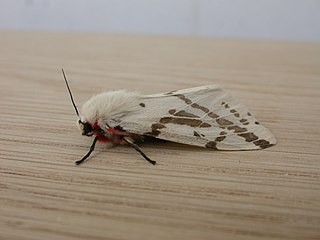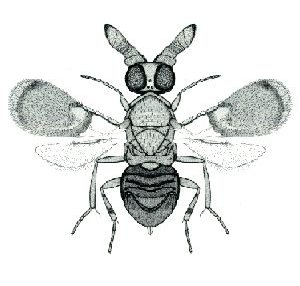
Chalcid wasps are insects within the superfamily Chalcidoidea, part of the order Hymenoptera. The superfamily contains some 22,500 known species, and an estimated total diversity of more than 500,000 species, meaning the vast majority have yet to be discovered and described. The name "chalcid" is often confused with the name "chalcidid", though the latter refers strictly to one constituent family, the Chalcididae, rather than the superfamily as a whole; accordingly, most recent publications (e.g.,) use the name "chalcidoid" when referring to members of the superfamily.

William Harris Ashmead was an American entomologist born on 19 September 1855 at Philadelphia. He died 17 October 1908 at Washington D.C.

Ardices canescens, the dark-spotted tiger moth or light ermine moth, is a moth in the family Erebidae that is found across most of Australia. It originally was included in the genus Spilosoma, but later the generic status of Ardices was proven.

Anagyrus is a large genus of parasitic wasps from the family Encyrtidae. Anagyrus is distributed throughout the world. A subgenus of Anagyrus is known as Nesoanagyrus

The Pompilinae are a subfamily of the spider wasp family, Pompilidae, the species of which lay their eggs on the paralyzed bodies of their prey.

Encyrtinae is a subfamily of parasitic wasps in the family Encyrtidae.
Ooencyrtus marcelloi is a parasitic wasp belonging to the family Encyrtidae. The species was first discovered in 2008 in a tropical lowland rainforest in the Soberanía National Park around Gamboa, Panama. The scientific name was first published in 2010.
John Stuart Noyes is a Welsh entomologist.
Bassettia is a genus of gall wasps found in North America.
Austroencyrtus is a genus of parasitic wasps.

Psyllaephagus is a genus of chalcid wasps. It was named and circumscribed by William Harris Ashmead in 1900. As of 2019, Psyllaephagus contains approximately 245 species. They are found worldwide: Australia has 100 described species; the Palaearctic region has about 57 species, India has about 20, and Africa about 30.

Idiogramma is a genus of wasp. It is the only extant genus in the tribe Idiogrammatini.

Trogus is a genus of parasitoid wasp found in the Holarctic and Neotropic regions. It is placed in the subfamily Ichneumoninae and the tribe Ichneumonini. Trogus species are parasites of larvae and pupae of the swallowtail butterfly family, Papilionidae. The genus consists of twelve extant and one extinct species.
Parachalcerinys is a genus of wasp. As of 2018, three species are recognized, which are all found in Australia.
Plutarchia is a genus of chalcid wasp in the subfamily Eurytominae. Alexandre Arsène Girault first circumscribed the genus in 1925; its name honors Plutarch. The genus initially only comprised its type species, P. bicarinativentris, found in Australia. Subsequent species from South Asia and Nigeria have been described and transferred to Plutarchia.

Ooencyrtus kuvanae is a species of chalcid wasp. It was introduced to North America in 1908 to control Lymantria moths. In North America, it has become an active parasitoid of the invasive spotted lanternfly.

Chalcedectidae is a small family of chalcid wasps, previously classified as part of the subfamily Cleonyminae, in the polyphyletic family Pteromalidae. Most species are parasitoids of wood-boring beetles.
Svetlana Nikolaevna Myartseva is an entomologist from Turkmenistan, who is Professor at the Universidad Autónoma de Tamaulipas in Mexico. Her research interests lie in the systematics and biology of the families of parasitic chalcid wasps Encyrtidae and Aphelinidae.











